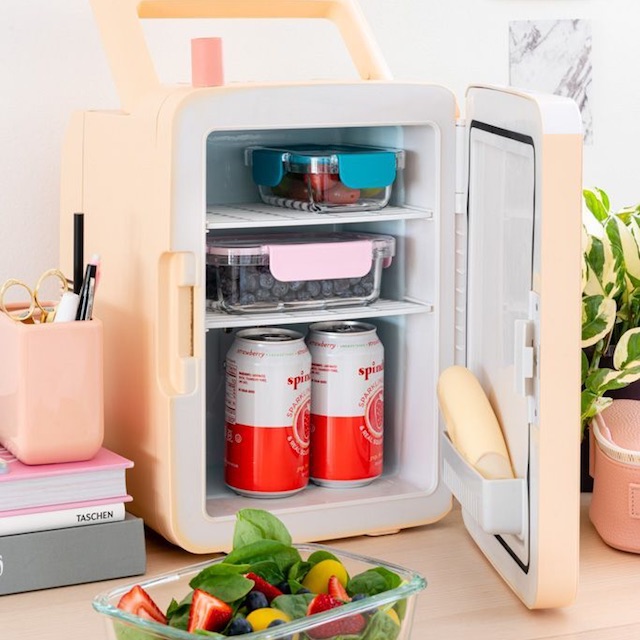Welcome to another detailed exploration at TheKitchenApplianceDad.com. Today, we’re diving into a common question that might seem simple at first but has more layers than you might expect: Can you put milk in a mini fridge? Whether you’re outfitting a dorm room, setting up a small office space, or simply need extra fridge space at home, understanding how to properly store milk in a mini fridge is crucial for ensuring freshness and safety.
Understanding Mini Fridges
Before we delve into the specifics of storing milk, let’s first understand what a mini fridge is. Mini fridges, also known as compact refrigerators, are smaller than their full-sized counterparts, typically ranging from 1.7 to 4.5 cubic feet. They are popular in spaces where room is limited or where a full-sized refrigerator is unnecessary.
Types of Mini Fridges:
- Thermoelectric Mini Fridges:
- These are powered by electricity and a cooling node, making them quieter but less capable of reaching lower temperatures compared to compressor-based fridges.
- Compressor Mini Fridges:
- Similar to standard refrigerators, these use a compressor and refrigerant, making them more effective at cooling and maintaining a stable temperature.
- Absorption Mini Fridges:
- Often used in hotels, these are silent and can run on various energy sources but are the least energy-efficient.

The Importance of Temperature
When it comes to storing milk, temperature is paramount. The USDA recommends keeping your fridge at or below 40°F (4°C) to prevent bacterial growth and keep milk fresh and safe to consume.
Challenges with Mini Fridges:
- Temperature Stability: Mini fridges can suffer from uneven cooling and temperature fluctuations, especially thermoelectric models. This can be a problem for milk, which requires consistent cool temperatures.
- Cold Spots: Many mini fridges have areas that are colder than others, typically at the back or near the cooling element. Placing milk in these spots can lead to freezing, altering the milk’s texture and taste.
Best Practices for Storing Milk in a Mini Fridge
To ensure that your milk remains fresh and delicious in a mini fridge, consider the following tips:
1. Check the Temperature:
- Use a fridge thermometer to monitor the temperature in your mini fridge regularly. Adjust the settings to maintain a consistent temperature below 40°F.
2. Place Milk Properly:
- Avoid storing milk in the door of the mini fridge, as the temperature here fluctuates with frequent opening and closing. Instead, place milk on a shelf closer to the back of the fridge, but be cautious of areas that might freeze.
3. Keep the Fridge Uncluttered:
- Overfilling a mini fridge can obstruct air circulation, leading to uneven cooling. Make sure there is enough space around items for air to move freely.
4. Regular Maintenance:
- Keep your mini fridge clean and defrost it regularly to ensure it operates at peak efficiency. This helps maintain a stable temperature and prevents odors and contamination.
Considerations Before Buying a Mini Fridge for Milk
If you are considering purchasing a mini fridge primarily for storing dairy products like milk, keep these factors in mind:
Size and Capacity:
- Choose a mini fridge that’s big enough to store all necessary items but compact enough for your space. Consider future needs as well.
Type of Mini Fridge:
- Opt for a compressor-based mini fridge for better temperature control. These models are more reliable for storing sensitive products like milk.
Energy Efficiency:
- Look for energy-efficient models to reduce electricity usage and environmental impact. Energy Star-rated appliances are a good choice.
Warranty and Brand Reputation:
- Purchase from a reputable brand with a good warranty period to ensure support in case of defects or issues.
Conclusion
Storing milk in a mini fridge is certainly feasible, but it requires more attention to detail compared to using a standard refrigerator. Temperature management is the key to keeping milk fresh and safe in a compact cooling environment.
Key Takeaways
- Temperature Regulation: Always keep the mini fridge at or below 40°F.
- Proper Placement: Store milk away from the fridge door and check for cold spots to prevent freezing.
- Maintenance: Regularly clean and defrost your mini fridge to maintain its efficiency.
- Choose Wisely: Consider a compressor-based mini fridge for better performance in cooling milk.
By following these guidelines, you can enjoy the convenience of a mini fridge without compromising on the quality and safety of your milk. Visit us at TheKitchenApplianceDad.com for more insights and tips on making the most of your kitchen appliances and ensuring they meet your culinary needs.


